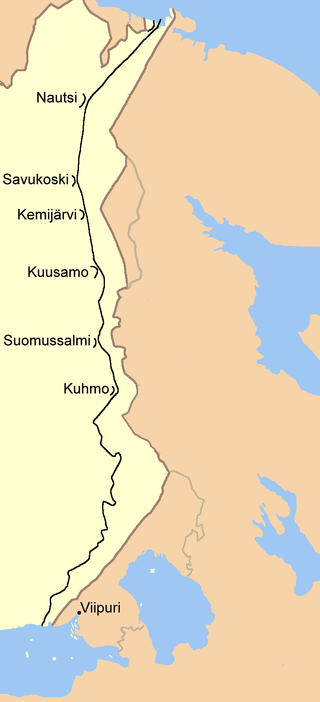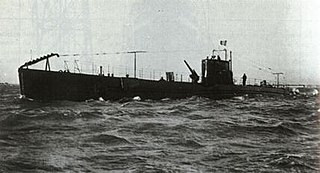
Johann Georg Wagler was a German herpetologist and ornithologist.

The Salpa Line, or its official name, Suomen Salpa, is a bunker line on the eastern border of Finland. It was built in 1940–1941 during the Interim Peace between the Winter War and the Continuation War and further in 1944 to defend Finland against a possible Soviet invasion.

Bonitos are a tribe of medium-sized, ray-finned predatory fish in the family Scombridae – a family it shares with the mackerel, tuna, and Spanish mackerel tribes, and also the butterfly kingfish. Also called the tribe Sardini, it consists of eight species across four genera; three of those four genera are monotypic, having a single species each. Bonitos closely resemble the skipjack tuna, which is often called a bonito, especially in Japanese contexts.

Thaliacea is a class of marine animals within the subphylum Tunicata, comprising the salps, pyrosomes and doliolids. Unlike their benthic relatives the ascidians, from which they are believed to have emerged, thaliaceans are free-floating (pelagic) for their entire lifespan. The group includes species with complex life cycles, with both solitary and colonial forms.

A salp or salpa is a barrel-shaped, planktonic tunicate in the family Salpidae. It moves by contracting, thereby pumping water through its gelatinous body, one of the most efficient examples of jet propulsion in the animal kingdom. The salp strains the pumped water through its internal feeding filters, feeding on phytoplankton.

Pompanos are marine fish in the genus Trachinotus in the family Carangidae. Pompano may also refer to various other, similarly shaped members of the Carangidae, or the order Perciformes. Their appearance is of deep-bodied fishes, exhibiting strong lateral compression, with a rounded face and pronounced curve to the anterior portion of their dorsal profile. Their ventral profile is noticeably less curved by comparison, while their anterior profile is straight-edged, tapering sharply to a narrow caudal peduncle. Their dorsal and anal fins are typically sickle-shaped, with very long anterior rays and a succession of much shorter rays behind, with a similarly long & curved, deeply forked tail which has a narrow base. They are typically overall silvery in color, sometimes with dark or yellowish fins, and one or a few black markings on the side of their body. They are toothless and are relatively large fish, up to about 1.2 m (3.9 ft) long, although most species reach no more than half or two-thirds of that size. They are found worldwide in warmer seas, sometimes also entering brackish waters.
Ichthyoallyeinotoxism, or hallucinogenic fish inebriation, comes from eating certain species of fish found in several parts of the tropics, the effects of which are reputed to be similar in some aspects to LSD. Experiences may include vivid auditory and visual hallucinations. This has given rise to the collective common name "dream fish" for ichthyoallyeinotoxic fish.

The VKT-line or Viipuri–Kuparsaari–Taipale line was a Finnish defensive line on Karelian Isthmus during the Continuation War, spanning from Viipuri (Vyborg) through Tali and Kuparsaari along the northern shore of Vuoksi River, Suvanto and Taipaleenjoki to Taipale on the western shore of Lake Ladoga, using natural benefits of the eastern part of the destroyed Mannerheim Line.

Sarpa salpa, known commonly as the dreamfish, salema, salema porgy, cow bream, karanteen, salpa, saupe or goldline, is a species of sea bream, recognisable by the golden stripes that run down the length of its body, and which can cause ichthyoallyeinotoxism when eaten. It is found in the East Atlantic, where it ranges from the Bay of Biscay to South Africa, as well as in the Mediterranean. It has occasionally been found as far north as Great Britain. It is generally common and found from near the surface to a depth of 70 m (230 ft).

Several species of fish are claimed to produce hallucinogenic effects when consumed. For example, Sarpa salpa, a species of sea bream, is commonly claimed to be hallucinogenic. These widely distributed coastal fish are normally found in the Mediterranean and around Spain, and along the west and south coasts of Africa. Occasionally they are found in British waters. They may induce hallucinogenic effects similar to LSD if eaten. However, based on the reports of exposure they are more likely to resemble hallucinogenic effects of deliriants than the effects of serotonergic psychedelics such as LSD. In 2006, two men who apparently ate the fish experienced hallucinations lasting for several days. The likelihood of hallucinations depends on the season. Sarpa salpa is known as "the fish that makes dreams" in Arabic.

Georgia Salpa Penna is a Greek-Irish glamour model.
The Salpa Line Museum was established and opened in 1987 by the municipality of Miehikkälä and by World War II veteran organisations. It is the first museum established in Miehikkälä. The other museums are the Miehikkälän kotiseutumuseo and the Miehikkälä local arts and crafts museum, which was established in 1989 and is located in the same building as the Engineers Museum.

The laughingthrushes are a family, Leiothrichidae, of Old World passerine birds. The family contains 133 species which are divided into 16 genera. They are diverse in size and coloration. These are birds of tropical areas, with the greatest variety in Southeast Asia and the Indian subcontinent. The entire family used to be included in the Old World babbler family Timaliidae.
Karl Heider was an Austrian zoologist and embryologist known for his research involving the developmental history of invertebrates. He was the son of Moriz Heider, a pioneer of scientific dentistry in Austria.

Salpa fusiformis, sometimes known as the common salp, is the most widespread species of salp. They have a cosmopolitan distribution, and can be found at depths of 0 to 800 m. They exhibit diel vertical migration, moving closer to the surface at night. They can occur in very dense swarms, as solitary zooids or as colonies. Solitary zooids usually measure 22 to 52 mm in length. They are barrel-shaped and elongated, with a rounded front and a flat rear. Aggregate zooids are 7 to 52 mm in length individually. They are usually barrel or spindle-shaped.

The Argonauta-class submarine was the first sub-class of the 600 Series of coastal submarines built for the Regia Marina during the 1930s. Some of these boats played a minor role in the Spanish Civil War of 1936–1939 supporting the Spanish Nationalists. Of the seven boats built in this class, only a single one survived the Second World War.
Cyclosalpa is a genus of salps, marine tunicates in the class Thaliacea.
Salpa was the name of at least two ships of the Italian Navy and may refer to:
Salpa Pokhari or Salpa Pond is a natural lake located in Dobhane village, Bhojpur District, Nepal. The lake lies at an altitude of 3443 metres and drains into the Sunkoshi River watershed.











